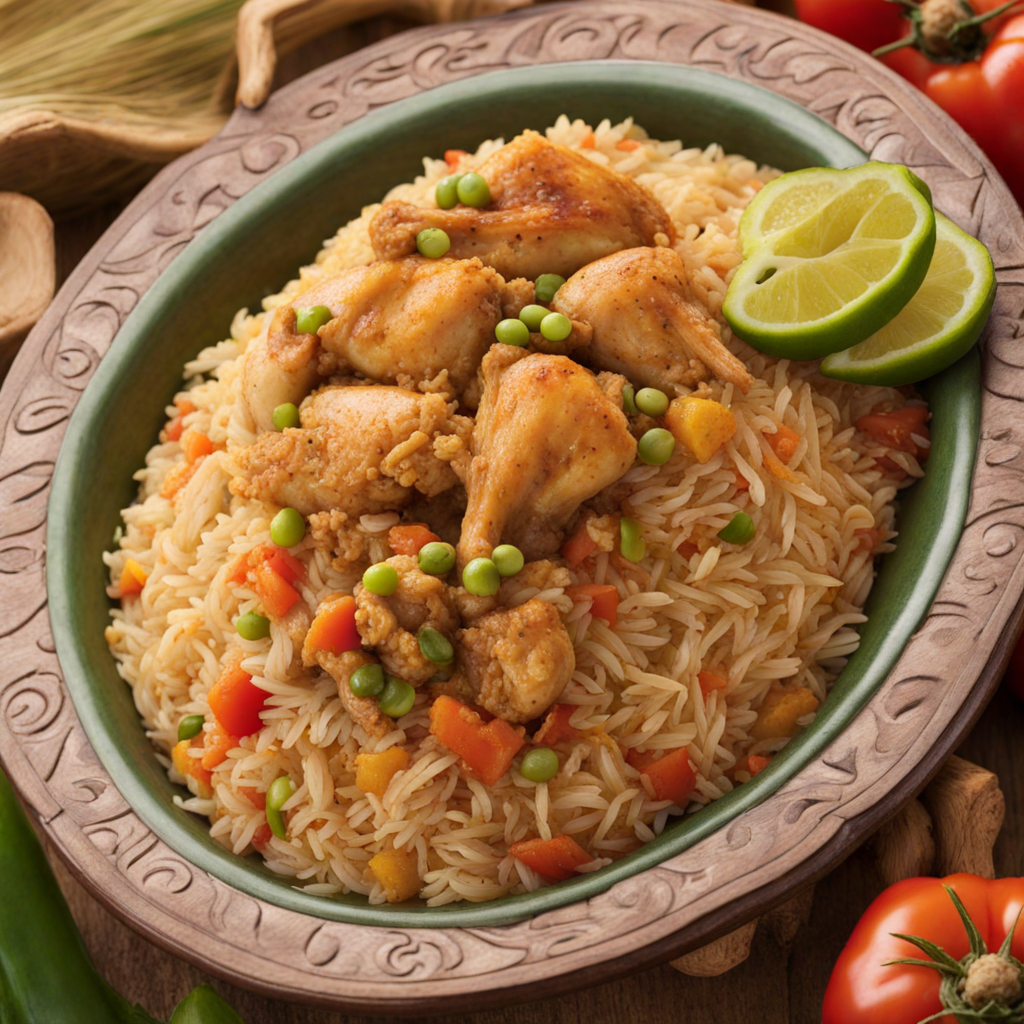Arroz con Pollo
Arroz con Pollo, a beloved dish in Panama, is a flavorful and hearty one-pot meal that beautifully showcases the country’s culinary influences, blending Indigenous, Spanish, and Afro-Caribbean elements. The dish, which translates to "rice with chicken," is a staple in Panamanian households and often served during family gatherings, celebrations, and special occasions. Its roots can be traced back to Spanish colonization, where rice became a primary staple in the diet, combined with locally available ingredients and cooking techniques. The preparation of Arroz con Pollo is a labor of love, typically requiring several steps to achieve the perfect balance of flavors and textures. The cooking process begins with marinating chicken pieces—usually thighs or drumsticks—in a mixture of spices, herbs, and sometimes citrus juices, allowing the flavors to penetrate the meat. Common seasonings include cumin, oregano, garlic, and sometimes a splash of beer for depth. The marinated chicken is then browned in a large pot, which adds a rich color and depth of flavor. Once the chicken is seared, the next stage involves aromatics, such as finely chopped onions, bell peppers, and tomatoes, which are sautéed until soft and fragrant. This mixture forms the base of the dish, often referred to as "sofrito." The addition of peas and carrots not only introduces vibrant colors but also adds sweetness and texture to the dish. A signature ingredient in Panamanian Arroz con Pollo is achiote or annatto,
How It Became This Dish
Arroz con Pollo: A Culinary Journey Through Panama Arroz con Pollo, a dish that translates to "rice with chicken," is a staple in many Latin American countries, but its roots and cultural significance in Panama are particularly rich and noteworthy. This vibrant dish is more than just a meal; it is a culinary embodiment of Panama's diverse cultural history, reflecting the influences of indigenous peoples, Spanish colonizers, African heritage, and Caribbean flavors. Origins The origins of Arroz con Pollo can be traced back to the early colonial period in Latin America when Spanish settlers brought their culinary traditions to the New World. The dish is believed to have evolved from Spanish paella, a rice dish that typically includes various proteins, often seafood or rabbit, and is known for its saffron-infused flavor. As the Spanish established colonies, they adapted their recipes to incorporate local ingredients available in their new environment. In Panama, the indigenous peoples had their own rice-based dishes, often featuring local vegetables and meats. With the introduction of rice as a staple food from Asia, particularly from the Philippines via the Manila Galleons, the stage was set for a unique fusion of culinary traditions. By merging the Spanish techniques of cooking rice with chicken with indigenous ingredients and practices, Arroz con Pollo took on a distinctly Panamanian character. Cultural Significance Arroz con Pollo holds a special place in Panamanian culture. It is often served during family gatherings, celebrations, and significant events, symbolizing unity and tradition. The dish is also a common feature at national holidays, birthday parties, and festive occasions, where it brings people together around the table. In Panamanian households, it is not just a means of nourishment but also a medium for storytelling, where recipes are passed down through generations, preserving familial and cultural heritage. The preparation of Arroz con Pollo also reflects the communal spirit of Panamanian culture. Families often come together to cook the dish, with each person contributing their own flair to the recipe—be it through the choice of spices, vegetables, or cooking techniques. This collaborative cooking experience reinforces familial bonds and cultural identity, showcasing how food can act as a vehicle for connection and community. Ingredients and Variations The quintessential Panamanian Arroz con Pollo is characterized by its vibrant yellow hue, which is typically achieved through the use of annatto (achiote) or saffron. The dish generally features chicken, which is marinated and then cooked with a medley of vegetables such as bell peppers, onions, and tomatoes. Long-grain rice is commonly used, absorbing the flavors of the chicken and spices throughout the cooking process. While the basic recipe remains consistent, regional variations exist across Panama. Coastal areas may incorporate seafood or coconut milk, reflecting the abundance of marine resources, while rural areas might include locally sourced vegetables and herbs. Additionally, Afro-Panamanian influences, particularly from the Caribbean, often introduce ingredients such as hot peppers and spices, giving the dish a distinctive kick. One popular variation is the "Arroz con Pollo a la Panameña," which includes green olives and capers, adding a briny contrast to the savory flavors of the chicken and rice. Each family may have its own unique twist, which is cherished as part of their culinary tradition. Development Over Time As Panama evolved through the centuries, so too did Arroz con Pollo. The construction of the Panama Canal in the early 20th century brought an influx of workers and immigrants from around the world, including the Caribbean, Europe, and Asia. This melting pot of cultures influenced not only the culinary landscape but also the way Arroz con Pollo was prepared and enjoyed. In the mid-20th century, as Panama embraced a more globalized culinary scene, Arroz con Pollo began to gain recognition beyond its traditional roots. It became a dish that represented Panamanian identity on the international stage, often featured in restaurants and cultural festivals. The rise of food tourism in Panama has also contributed to the dish's visibility, with tourists eager to experience authentic local cuisine. In contemporary Panama, chefs are reinterpreting Arroz con Pollo, blending traditional techniques with modern culinary innovations. Some chefs experiment with fusion recipes, incorporating international flavors and cooking methods while maintaining the essence of the dish. This creative evolution reflects the dynamic nature of Panamanian cuisine, which continues to adapt while honoring its rich heritage. Conclusion Arroz con Pollo is much more than a simple rice and chicken dish; it is a reflection of Panama’s rich history and cultural diversity. From its humble beginnings influenced by indigenous and Spanish cooking to its status as a beloved national dish, it encapsulates the spirit of community and tradition that defines Panamanian culture. As Panamanians gather around the table to share this flavorful meal, they are not just nourishing their bodies but also keeping alive a legacy that speaks to their identity, resilience, and connection to one another. In every spoonful of Arroz con Pollo, there lies a story of history, culture, and the enduring power of food to bring people together. Whether enjoyed at a family gathering or a festive celebration, this dish remains a cherished symbol of Panamanian heritage, one that will continue to evolve while staying true to its roots.
You may like
Discover local flavors from Panama







